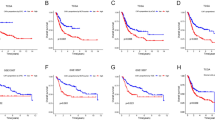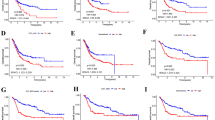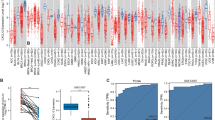Abstract
As one of important components of tumor microenvironment, CAFs (cancer-associated fibroblasts) play a vital role in the development and metastasis of bladder cancer. The present study aimed to develop a CAFs-related gene signature to predict the prognosis of patients and the response to chemotherapy and immunotherapy based on research of multidatabase. Expression data and clinical information were obtained from TCGA and GEO databases. Different bioinformatic and statistical methods were combined to construct the robust CAFs-related gene signature for prognosis. The model was explored from four aspects: single-cell source, immune infiltration, correlation with cancer-related genes and pathways, and prediction of drug response. After screening, five genes (BNC2, LAMA2, MFAP5, NID1, and OLFML1) related to CAFs were used for constructing the signature to divide patients into high- and low-risk groups. Patients in low-risk group had better prognosis and multidatabase analysis confirmed the predictive value. The five genes were mainly expressed by fibroblasts and involved in regulation of pathways related with glycolysis, hypoxia, and epithelial–mesenchymal transition (EMT). BNC2, LAMA2, and NID1 were strongly associated with drug sensitivity. Moreover, the immunological status was different between high- and low-risk groups. High-risk patients had poor response to chemotherapy or immunotherapy. The CAFs-related gene signature might help to optimize risk stratification and provide a new insight in individual treatment for bladder cancer.











Similar content being viewed by others
Data availability
All the data in our study can be accessed from the online databases.
Abbreviations
- CAFs:
-
Cancer-associated fibroblasts
- BLCA:
-
Bladder cancer
- TME:
-
Tumor microenvironment
- TCGA:
-
The cancer genome atlas
- MIBC:
-
Muscle invasive bladder cancer
- NMIBC:
-
Non-muscle invasive bladder cancer
- TMB:
-
Tumor mutation burden
- DEGs:
-
Differentially expressed genes
- WGCNA:
-
Weighted gene co-expression network analysis
References
Richters A, Aben KKH, Kiemeney L. The global burden of urinary bladder cancer: an update. World J Urol. 2020;38(8):1895–904. https://doi.org/10.1007/s00345-019-02984-4.
Hedegaard J, Lamy P, Nordentoft I, Algaba F, Hoyer S, Ulhoi BP, et al. Comprehensive transcriptional analysis of early-stage urothelial carcinoma. Cancer Cell. 2016;30(1):27–42. https://doi.org/10.1016/j.ccell.2016.05.004.
Fong MHY, Feng M, McConkey DJ, Choi W. Update on bladder cancer molecular subtypes. Transl Androl Urol. 2020;9(6):2881–9. https://doi.org/10.21037/tau-2019-mibc-12.
Sjodahl G, Eriksson P, Liedberg F, Hoglund M. Molecular classification of urothelial carcinoma: global mRNA classification versus tumour-cell phenotype classification. J Pathol. 2017;242(1):113–25. https://doi.org/10.1002/path.4886.
Dzobo K, Dandara C. Architecture of cancer-associated fibroblasts in tumor microenvironment: mapping their origins, heterogeneity, and role in cancer therapy resistance. OMICS. 2020;24(6):314–39. https://doi.org/10.1089/omi.2020.0023.
Villaronga MA, Teijeiro SA, Hermida-Prado F, Garzon-Arango M, Sanz-Moreno V, Garcia-Pedrero JM. Analysis of invasive activity of CAF spheroids into three dimensional (3D) collagen matrices. Methods Mol Biol. 2018;1731:145–54. https://doi.org/10.1007/978-1-4939-7595-2_14.
Bertero T, Oldham WM, Grasset EM, Bourget I, Boulter E, Pisano S, et al. Tumor-stroma mechanics coordinate amino acid availability to sustain tumor growth and malignancy. Cell Metab. 2019;29(1):124–40. https://doi.org/10.1016/j.cmet.2018.09.012.
Yoshihara K, Shahmoradgoli M, Martinez E, Vegesna R, Kim H, Torres-Garcia W, et al. Inferring tumour purity and stromal and immune cell admixture from expression data. Nat Commun. 2013;4:2612. https://doi.org/10.1038/ncomms3612.
Racle J, de Jonge K, Baumgaertner P, Speiser DE, Gfeller D. Simultaneous enumeration of cancer and immune cell types from bulk tumor gene expression data. Elife. 2017. https://doi.org/10.7554/eLife.26476.
Yu G, Wang LG, Han Y, He QY. clusterProfiler: an R package for comparing biological themes among gene clusters. OMICS. 2012;16(5):284–7. https://doi.org/10.1089/omi.2011.0118.
Langfelder P, Horvath S. WGCNA: an R package for weighted correlation network analysis. BMC Bioinform. 2008;9:559. https://doi.org/10.1186/1471-2105-9-559.
Szklarczyk D, Gable AL, Lyon D, Junge A, Wyder S, Huerta-Cepas J, et al. STRING v11: protein-protein association networks with increased coverage, supporting functional discovery in genome-wide experimental datasets. Nucleic Acids Res. 2019;47(D1):D607–13. https://doi.org/10.1093/nar/gky1131.
Shannon P, Markiel A, Ozier O, Baliga NS, Wang JT, Ramage D, et al. Cytoscape: a software environment for integrated models of biomolecular interaction networks. Genome Res. 2003;13(11):2498–504. https://doi.org/10.1101/gr.1239303.
Sun D, Wang J, Han Y, Dong X, Ge J, Zheng R, et al. TISCH: a comprehensive web resource enabling interactive single-cell transcriptome visualization of tumor microenvironment. Nucleic Acids Res. 2021;49(D1):D1420–30. https://doi.org/10.1093/nar/gkaa1020.
Newman AM, Liu CL, Green MR, Gentles AJ, Feng W, Xu Y, et al. Robust enumeration of cell subsets from tissue expression profiles. Nat Methods. 2015;12(5):453–7. https://doi.org/10.1038/nmeth.3337.
Li T, Fu J, Zeng Z, Cohen D, Li J, Chen Q, et al. TIMER20 for analysis of tumor-infiltrating immune cells. Nucleic Acids Res. 2020;48(W1):W509–14. https://doi.org/10.1093/nar/gkaa407.
Fu J, Li K, Zhang W, Wan C, Zhang J, Jiang P, et al. Large-scale public data reuse to model immunotherapy response and resistance. Genome Med. 2020;12(1):21. https://doi.org/10.1186/s13073-020-0721-z.
Liu CJ, Hu FF, Xia MX, Han L, Zhang Q, Guo AY. GSCALite: a web server for gene set cancer analysis. Bioinformatics. 2018;34(21):3771–2. https://doi.org/10.1093/bioinformatics/bty411.
Long X, Xiong W, Zeng X, Qi L, Cai Y, Mo M, et al. Cancer-associated fibroblasts promote cisplatin resistance in bladder cancer cells by increasing IGF-1/ERbeta/Bcl-2 signalling. Cell Death Dis. 2019;10(5):375. https://doi.org/10.1038/s41419-019-1581-6.
Costa A, Kieffer Y, Scholer-Dahirel A, Pelon F, Bourachot B, Cardon M, et al. Fibroblast heterogeneity and immunosuppressive environment in human breast cancer. Cancer Cell. 2018;33(3):463–79. https://doi.org/10.1016/j.ccell.2018.01.011.
Shan T, Chen S, Chen X, Lin WR, Li W, Ma J, et al. Prometastatic mechanisms of CAF-mediated EMT regulation in pancreatic cancer cells. Int J Oncol. 2017;50(1):121–8. https://doi.org/10.3892/ijo.2016.3779.
Kechagia JZ, Ivaska J, Roca-Cusachs P. Integrins as biomechanical sensors of the microenvironment. Nat Rev Mol Cell Biol. 2019;20(8):457–73. https://doi.org/10.1038/s41580-019-0134-2.
Mohammadi H, Sahai E. Mechanisms and impact of altered tumour mechanics. Nat Cell Biol. 2018;20(7):766–74. https://doi.org/10.1038/s41556-018-0131-2.
Paszek MJ, Zahir N, Johnson KR, Lakins JN, Rozenberg GI, Gefen A, et al. Tensional homeostasis and the malignant phenotype. Cancer Cell. 2005;8(3):241–54. https://doi.org/10.1016/j.ccr.2005.08.010.
Monteran L, Erez N. The dark side of fibroblasts: cancer-associated fibroblasts as mediators of immunosuppression in the tumor microenvironment. Front Immunol. 2019;10:1835. https://doi.org/10.3389/fimmu.2019.01835.
Martinez-Outschoorn UE, Lisanti MP, Sotgia F. Catabolic cancer-associated fibroblasts transfer energy and biomass to anabolic cancer cells, fueling tumor growth. Semin Cancer Biol. 2014;25:47–60. https://doi.org/10.1016/j.semcancer.2014.01.005.
Vanhoutteghem A, Djian P. Basonuclin 2: an extremely conserved homolog of the zinc finger protein basonuclin. Proc Natl Acad Sci USA. 2004;101(10):3468–73. https://doi.org/10.1073/pnas.0400268101.
Urgard E, Reigo A, Reinmaa E, Rebane A, Metspalu A. Human basonuclin 2 up-regulates a cascade set of interferon-stimulated genes with anti-cancerous properties in a lung cancer model. Cancer Cell Int. 2017;17:18. https://doi.org/10.1186/s12935-017-0394-x.
Akagi T, Ito T, Kato M, Jin Z, Cheng Y, Kan T, et al. Chromosomal abnormalities and novel disease-related regions in progression from Barrett’s esophagus to esophageal adenocarcinoma. Int J Cancer. 2009;125(10):2349–59. https://doi.org/10.1002/ijc.24620.
Cesaratto L, Grisard E, Coan M, Zandona L, De Mattia E, Poletto E, et al. BNC2 is a putative tumor suppressor gene in high-grade serous ovarian carcinoma and impacts cell survival after oxidative stress. Cell Death Dis. 2016;7(9): e2374. https://doi.org/10.1038/cddis.2016.278.
Murakami K, Kikugawa S, Kobayashi Y, Uehara S, Suzuki T, Kato H, et al. Olfactomedin-like protein OLFML1 inhibits Hippo signaling and mineralization in osteoblasts. Biochem Biophys Res Commun. 2018;505(2):419–25. https://doi.org/10.1016/j.bbrc.2018.09.112.
Wan B, Zhou YB, Zhang X, Zhu H, Huo K, Han ZG. hOLFML1, a novel secreted glycoprotein, enhances the proliferation of human cancer cell lines in vitro. FEBS Lett. 2008;582(21–22):3185–92. https://doi.org/10.1016/j.febslet.2008.08.009.
Patarroyo M, Tryggvason K, Virtanen I. Laminin isoforms in tumor invasion, angiogenesis and metastasis. Semin Cancer Biol. 2002;12(3):197–207. https://doi.org/10.1016/s1044-579x(02)00023-8.
Lee S, Oh T, Chung H, Rha S, Kim C, Moon Y, et al. Identification of GABRA1 and LAMA2 as new DNA methylation markers in colorectal cancer. Int J Oncol. 2012;40(3):889–98. https://doi.org/10.3892/ijo.2011.1245.
Vitolo D, Ciocci L, Deriu G, Spinelli S, Cortese S, Masuelli L, et al. Laminin alpha2 chain-positive vessels and epidermal growth factor in lung neuroendocrine carcinoma: a model of a novel cooperative role of laminin-2 and epidermal growth factor in vessel neoplastic invasion and metastasis. Am J Pathol. 2006;168(3):991–1003. https://doi.org/10.2353/ajpath.2006.041310.
Lemaire R, Bayle J, Mecham RP, Lafyatis R. Microfibril-associated MAGP-2 stimulates elastic fiber assembly. J Biol Chem. 2007;282(1):800–8. https://doi.org/10.1074/jbc.M609692200.
Zhou Z, Cui D, Sun MH, Huang JL, Deng Z, Han BM, et al. CAFs-derived MFAP5 promotes bladder cancer malignant behavior through NOTCH2/HEY1 signaling. FASEB J. 2020;34(6):7970–88. https://doi.org/10.1096/fj.201902659R.
Xu Q, Chang H, Tian X, Lou C, Ma H, Yang X. Hypoxia-induced MFAP5 promotes tumor migration and invasion via AKT pathway in head and neck squamous cell carcinoma. J Cancer. 2020;11(6):1596–605. https://doi.org/10.7150/jca.38217.
Yeung TL, Leung CS, Yip KP, Sheng J, Vien L, Bover LC, et al. Anticancer immunotherapy by MFAP5 blockade inhibits fibrosis and enhances chemosensitivity in ovarian and pancreatic cancer. Clin Cancer Res. 2019;25(21):6417–28. https://doi.org/10.1158/1078-0432.CCR-19-0187.
Pedrola N, Devis L, Llaurado M, Campoy I, Martinez-Garcia E, Garcia M, et al. Nidogen 1 and nuclear protein 1: novel targets of ETV5 transcription factor involved in endometrial cancer invasion. Clin Exp Metastasis. 2015;32(5):467–78. https://doi.org/10.1007/s10585-015-9720-7.
Zhou Y, Zhu Y, Fan X, Zhang C, Wang Y, Zhang L, et al. NID1, a new regulator of EMT required for metastasis and chemoresistance of ovarian cancer cells. Oncotarget. 2017;8(20):33110–21. https://doi.org/10.18632/oncotarget.16145.
Mao X, Tey SK, Yeung CLS, Kwong EML, Fung YME, Chung CYS, et al. Nidogen 1-enriched extracellular vesicles facilitate extrahepatic metastasis of liver cancer by activating pulmonary fibroblasts to secrete tumor necrosis factor receptor 1. Adv Sci (Weinh). 2020;7(21):2002157. https://doi.org/10.1002/advs.202002157.
Acknowledgements
This work was supported by the National Natural Science Foundation of China (Grant No. 82071750, 81772713, 81472411), Taishan Scholar Program of Shandong Province (Grant No. tsqn20161077), Major Science and technology innovation project of Shandong Province (Grant No. 2019JZZY021002), Key projects of Qingdao Science and Technology Program (Grant No. 18-6-1-64-nsh), and Research and Development Program of Shandong Province (Grant No. 2018GSF118197).
Author information
Authors and Affiliations
Contributions
ZZ and HTN contributed to conception and design. ZJL, DL, and LPW contributed to collection and assembly of data. YL and YBC contributed to data analysis and interpretation. ZZ contributed to manuscript writing. WJ and HTN contributed to the manuscript revision and finalization.
Corresponding authors
Ethics declarations
Conflict of interest
The authors report no conflicts of interest in this work.
Ethics approval and consent to participate
Ethical approval for this study was obtained from the Ethics Committee of the affiliated hospital of Qingdao university.
Additional information
Publisher's Note
Springer Nature remains neutral with regard to jurisdictional claims in published maps and institutional affiliations.
Supplementary Information
Below is the link to the electronic supplementary material.
13577_2022_673_MOESM1_ESM.tif
Supplementary file1 (TIF 5739 KB) Supplementary figure 1. Immune infiltration analysis of the CAFs-related gene signature. (A-E) Correlation analysis between the expressions of individual genes and infiltration levels of B cell, CD8+ T cell, CD4+ T cell, macrophage, neutrophil, and dendritic cell. (F) Comparison of the infiltration of 22 leukocyte types between high and low CRS groups.
13577_2022_673_MOESM2_ESM.tif
Supplementary file2 (TIF 1833 KB) Supplementary figure 2. (A-E) The comparison of tumor infiltration levels among tumors with different somatic copy number alterations for the model genes. (F) Waterfall plot showing the mutation information for the model genes in TCGA.
13577_2022_673_MOESM3_ESM.tif
Supplementary file3 (TIF 1009 KB) Supplementary figure 3. The gene set drug sensitivity analysis from CTRP drug data. The color from blue to red represent the correlation between mRNA expression and IC50 (50% inhibitory concentration) of small molecules/drugs.
Rights and permissions
About this article
Cite this article
Zhang, Z., Liang, Z., Li, D. et al. Development of a CAFs-related gene signature to predict survival and drug response in bladder cancer. Human Cell 35, 649–664 (2022). https://doi.org/10.1007/s13577-022-00673-w
Received:
Accepted:
Published:
Issue Date:
DOI: https://doi.org/10.1007/s13577-022-00673-w




